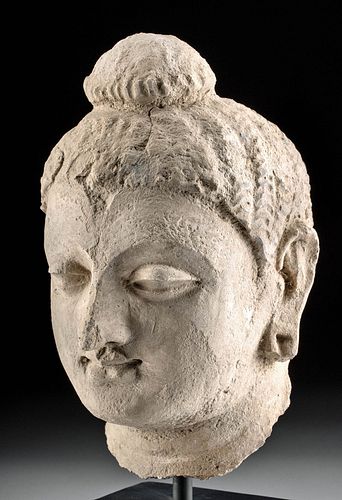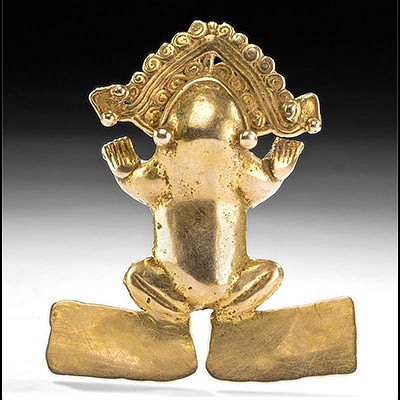Fine Gandharan Stucco Head
Lot 55b
About Seller
Artemis Fine Arts
686 S Taylor Ave, Ste 106
Louisville, CO 80027
United States
Selling antiquities, ancient and ethnographic art online since 1993, Artemis Gallery specializes in Classical Antiquities (Egyptian, Greek, Roman, Near Eastern), Asian, Pre-Columbian, African / Tribal / Oceanographic art. Our extensive inventory includes pottery, stone, metal, wood, glass and textil...Read more
Categories
Estimate:
$2,500 - $3,500
Absentee vs Live bid
Two ways to bid:
- Leave a max absentee bid and the platform will bid on your behalf up to your maximum bid during the live auction.
- Bid live during the auction and your bids will be submitted real-time to the auctioneer.
Bid Increments
| Price | Bid Increment |
|---|---|
| $0 | $25 |
| $300 | $50 |
| $1,000 | $100 |
| $2,000 | $250 |
| $5,000 | $500 |
| $10,000 | $1,000 |
| $20,000 | $2,500 |
| $50,000 | $5,000 |
| $100,000 | $10,000 |
| $200,000 | $20,000 |
About Auction
By Artemis Fine Arts
Aug 13, 2020
Set Reminder
2020-08-13 10:00:00
2020-08-13 10:00:00
America/New_York
Bidsquare
Bidsquare : Fine Antiquities, Ethnographic & Fine Art
https://www.bidsquare.com/auctions/artemis-gallery/fine-antiquities-ethnographic-fine-art-5415
Features classical antiquities, ancient and ethnographic art from cultures encompassing the globe. Egyptian, Greek, Roman, Etruscan, Near Eastern, Asian, Pre-Columbian, Native American, African / Tribal, Oceanic, Spanish Colonial, Russian, Fine Art, so much more! Artemis Fine Arts info@artemisgallery.com
Features classical antiquities, ancient and ethnographic art from cultures encompassing the globe. Egyptian, Greek, Roman, Etruscan, Near Eastern, Asian, Pre-Columbian, Native American, African / Tribal, Oceanic, Spanish Colonial, Russian, Fine Art, so much more! Artemis Fine Arts info@artemisgallery.com
- Lot Description
Northwest Pakistan, ancient region of Gandhara, ca. 2nd to 4th century CE. A finely carved and skillfully stuccoed stone head of Buddha, presenting a sensitively modeled visage comprised of solemn half-closed eyes of an elegant almond shape, a long aquiline nose, and a gentle smile. The Buddha's facial planes are veristically contoured, this realistic quality complemented by details such those soft 'fleshy' lips and heavy eyelids. Traces of white pigment remain on the face and curled coiffure topped by an ushnisha. This technique shows stylistic affinities with the early stucco production from Gandharan sites, particularly Taxila. A special example of Greco-Buddhist art that demonstrates a strong syncretism between eastern and western traditions. Size: 4.5" W x 7" H (11.4 cm x 17.8 cm); 10" H (25.4 cm) on included custom stand.
Alexander the Great conquered Gandhara in 330 BCE and with the help of the Indo-Greek kings introduced classical traditions that would influence Gandharan art for the following seven centuries. The stylized curly Mediterranean hair and top knot that derive from the Apollo Belvedere (330 BCE), as well as the sensitive modeling of that tranquil visage displayed in this piece, for example, exhibit this classical influence.
Provenance: private East Coast, USA collection, ex-Dere collection, New Jersey, USA, acquired prior to 2008
All items legal to buy/sell under U.S. Statute covering cultural patrimony Code 2600, CHAPTER 14, and are guaranteed to be as described or your money back.
A Certificate of Authenticity will accompany all winning bids.
We ship worldwide and handle all shipping in-house for your convenience.
#157128Repaired from 2 large sections. Minor loss to stucco at top of forehead. Surface wear as shown.Condition
- Shipping Info
-
All shipping is handled in-house for your convenience. Your invoice from Artemis Gallery will include shipping calculation instructions. If in doubt, please inquire BEFORE bidding for estimated shipping costs for individual items.
-
- Buyer's Premium



 EUR
EUR CAD
CAD AUD
AUD GBP
GBP MXN
MXN HKD
HKD CNY
CNY MYR
MYR SEK
SEK SGD
SGD CHF
CHF THB
THB














